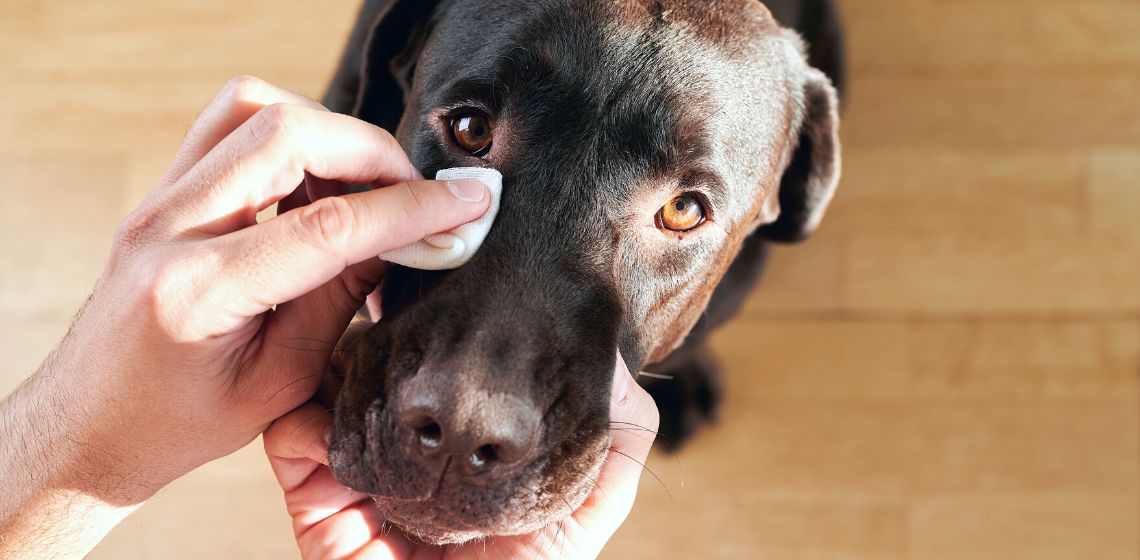Table of Contents
Corneal Ulcers in Dogs
Like us, dogs may get sores on their corneas. The eye’s cornea, which is its transparent outer layer, can develop an erosion, corneal abrasion, sore, dent, or divot in the eye, referred to as a corneal ulcer.
What are corneal ulcers in dogs?
Ulcerative keratitis or corneal ulcers commonly occur in dogs. An ulcer in the eye of a dog refers to a defect in the outermost portion of the eye, leading to swelling and inflammation. Ulcers can be superficial (only damaging the surface of the eye) or deep (damaging further into the tissue, making treatment more complex and the risk of complications higher).
Simple ulcers
Simple corneal ulcers generally are uncomplicated, not likely to be infected, occur acutely, and are superficial. While a superficial corneal ulcer just affects the cornea’s surface, it can become deep at any time. Bacterial infection, improper healing, and genetics, among other reasons, may lead to developing a deep ulcer.
Complicated ulcers
Complicated ulcers may be infected, take longer to heal, and require various therapies above and beyond the standard fare. Deep ulcers are complicated in nature. A deep ulcer occurs when deeper corneal tissue pushes through the outermost layer or when the cornea has been damaged all the way through, making a hole through the cornea.
Indolent ulcers
Indolent corneal ulcers (spontaneous chronic corneal epithelial defects) represent a subset of the complicated ulcers seen in dogs. They are often persistent, non-healing ulcers and commonly occur in Boxers.
Causes of eye ulcers in dogs
Corneal ulcers may arise in dogs for various reasons. Possible causes include
- Trauma – #1 reason we see corneal ulcers in dogs;
- Foreign material;
- Chemical irritation — e.g., shampoo or topical medications getting into the eyes);
- Infection — e.g., viral infections or bacteria. However, infection more commonly arises secondary to the ulcer rather than directly causing them;
- Chronic dry eye, AKA Keratoconjunctivitis sicca — Another common cause;
- Eye confirmation abnormalities — e.g., congenital (at birth), masses of the eyelids, abnormally placed eyelashes (distichia), entropion (lower lid rolls inward), ectopic cilia (lashes that grow towards the cornea);
- Abnormalities in neurologic function — blinking abnormalities;
- Genetics – various breeds have an inherited predisposition for conditions that increase the susceptibility to developing an ulcer, e.g., boxers, beagles, Afghan hounds, and Alaskan malamutes;
- Brachycephalic breeds – Those smushy-faced breeds everyone loves, pugs or Boston terriers, for example. With their short heads and increased eye exposure, they often lack sufficient blink coverage to protect the eyes. These breeds are more apt to traumatize the eye with everyday exploration and activities;
- Glaucoma — A disease that causes damage to the optic nerve and increases pressure in the eye.
Symptoms of eye ulcers in dogs
Corneal ulcers may cause various signs in dogs. The first four are the most commonly seen, but any number of symptoms can accompany eye sores. Symptoms of eye ulcers may include
- Squinting;
- Redness (around the eye; within the white of the eye—the sclera);
- Discharge — clear, yellow, green, brown, or combo; mucoid, thick or thin;
- Pain — Signs of a painful eye may include holding an eye shut completely, rubbing/pawing at the eye, or blinking excessively; some dogs may have a decreased appetite, not want to play or interact, and be sleepier than usual due to pain;
- Corneal cloudiness;
- Swelling of the sclera;
- Light sensitivity (photophobia);
Diagnosis of corneal ulcers in dogs
First and foremost, your veterinarian will obtain a complete history to diagnose an ulcer in your dog. The vet will discuss the clinical signs you are seeing and do a thorough physical exam, including a comprehensive eye (ophthalmic) exam with an ophthalmoscope.
The vet will assess your dog’s tear film production using the Schirmer tear test to further evaluate your dog’s eye. This checks for dry eye, a predisposing factor for ulcer development. Next, a test to check your dog’s eye pressure (tonometry) to rule out glaucoma is also performed.
Finally, a special dye, fluorescein stain, evaluates your dog’s cornea. This allows any defects to become visible, as only non-intact areas of the cornea take up this stain. Using a special light, your vet can assess if any abrasions or divots are present, confirming an ulcer.
If ulcers fail to heal, additional testing, such as culture and evaluating cells under the microscope, may be performed.
Treating canine corneal ulcers
If a dog with a sore eye is evaluated promptly by a veterinary professional, treating an ulcer can go smoothly. Your veterinarian will prescribe medications needed to treat the eye and control discomfort. Various medications help treat or prevent an underlying infection, avoid further damage to the eye, relax the muscles in the eye, and treat pain.
E-collars are a must
However, first and foremost, an essential thing to remember for dogs with an ulcer is that an e-collar (that stupid lampshade cone-like contraption) is a must! Frequently treatment failures occur not because the meds didn’t work but simply because the dog wasn’t wearing a cone. The e-collars prevent a dog from rubbing at the eyes with the paw, on the carpet, on the couch, or elsewhere causing further damage and preventing the eye from healing properly.
Minor corneal ulcer therapy
Minor corneal ulcers in dogs happen all the time. Treatment generally consists of
- An e-collar – to prevent self trauma
- Topical antibiotics are used to prevent secondary infections; (less commonly, antifungal or antiviral medications are needed);
- Pain medication (topical and or by mouth, depending on the pain level of the pooch) – Way too often, owners fail to realize that their dogs are painful. Pain delays the healing process. Thus, by treating our pet’s pain, we speed up recovery.
- Atropine — This medication dilates the eye (opens it more), which helps to relax the eye, treats pain, and minimizes complications and chronic changes to the eye as it heals. This helps facilitate healing.
Corneal ulcer complications
Sadly, not all corneal ulcer therapy goes smoothly. Corneal ulcers can be complicated. This may mean a superficial ulcer has become deep or an underlying infection isn’t responding to current medications. Additional reasons for corneal ulcer therapy failures or obstacles may include
- Owners who fail to use the e-collar as directed;
- Dogs who aren’t rested, getting too much off-leash exercise and causing repeat trauma;
- Certain breeds may not always respond to initial treatment or be prone to complications;,
- Corneal rupture;
- Develop a melting ulcer (severe infection, resistant to medications);
- Patients with underlying diseases that decrease the dog’s ability to heal, such as Cushing’s disease or diabetes, may lead to treatment difficulties;
- Failing to address any underlying causes of ulceration may prevent healing (if abnormal eyelashes are not removed, for example, ulcers may reoccur).
Additional therapies
Additional therapies may be needed to treat complicated ulcers or ulcers which fail to respond to standard remedies. This may include surgical management grafts, blood serum, contact lenses, and other options.
In severe cases, one serious complication, corneal rupture, may occur. This means the cornea is no longer intact. Dog eye ulcer rupture symptoms may include impaired vision, protrusion of other parts of the eye, such as the iris, and pain. If you suspect your pet ruptured its cornea while being treated for an ulcer, get them evaluated by a veterinarian ASAP, or vision loss may be permanent.
Recheck exam is crucial
Remember that a recheck with your veterinarian is the only way to know if an ulcer has healed. They need to restain the eye with that special dye and look with the special tool to see if the lesion has healed. The eye may not have totally recovered even when the dog’s symptoms have subsided. Stopping medications too soon could lead to the worsening of the ulcer or complications.
Corneal ulcer prognosis
Dogs with superficial corneal ulcers usually heal within about a week. Prognosis is good in most superficial cases and when owners follow directions closely. Controlling pain plays a role in prognosis when treating a pet’s corneal ulcer. E-collar compliance is essential to a rapid recovery.
However, not all dogs follow the rule books. Some breeds are predisposed to deep ulcers and can be challenging to heal. If owners wait too long to seek care, the dog paws or rubs at the eye and therapy directions aren’t carefully followed, permanent vision loss and even eye rupture can occur. Thus, recognizing signs of corneal damage in your dog and seeking timely treatment could make all the difference. Know the signs and seek care as soon as possible.
An ulcer’s seriousness depends on the dog, the dog’s breed, if the ulcer is deep or superficial, and how quickly the dog receives treatment, among other factors. Compliance with veterinary recommendations is critical to ensure recovery. Eye ulcers are painful, and failure to treat them promptly can lead to vision loss, corneal rupture, and even loss of the eye.
In theory, a dog’s body will start to heal the eye by developing healthy tissue over the wound, which will attach to the deeper layers. However, most of the time, dog ulcers don’t heal without intervention. Because dogs investigate their world with their nose, eyes, and mouth, anything irritating the already ulcerated eye can increase the risk of infection and damage. Thus, treatment is generally needed.
Simple, superficial ulcers generally take about one week to heal. However, deep ulcers and certain types of ulcers may require special procedures and longer-term therapy, taking weeks to months to heal.

Dr. Tramuta-Drobnis keeps herself busy as a veterinarian and public health professional, a freelancer, writer, and researcher. Receiving her Veterinary Medical Doctor degree (2005) from the University of Pennsylvania and her Master’s in Public Health from the University of Florida, she’s accrued over 17 years of veterinary clinical experience. Her work with small animals and exotics span general practice, emergency, and critical care medicine. She has a passion for One Health, infectious diseases, pain management, veterinary nutrition, and more.








